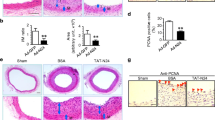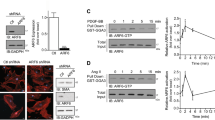Abstract
The Ser/Thr-protein kinase Pim-1 has been discovered as a novel transducer of survival- and cell cycle promoting signals in the hematopoietic cell system. Although its significance for proliferation of vascular smooth muscle cells (VSMC) in vitro and neointima formation in vivo has been suggested recently, the mechanism has barely been characterized. This study aimed to foster the understanding of Pim-1 expression and regulation in murine VSMC in response to factors typically present within the atherosclerotic plaque. While oxidative stress, VEGF-A165 and angiotensin II did not have any effect on Pim-1 expression, VSMC strongly increased (3-fold) Pim-1 mRNA upon stimulation with PDGFbb, followed by its protein upregulation. Half life of Pim-1 RNA and protein were determined to be 25 min and 6 h, respectively. PDGFbb induced a strong, 10-fold increase in BrdU-uptake, a marker of proliferation. This was effectively blocked by either Pim-1-specific inhibitor quercetagetin or adenovirally introduced Pim-1 shRNA. We further identified the signaling pathways linking PDGFbb to Pim-1 in VSMC: as expected, we determined transcriptional stimulation of Pim-1 via Janus-activated kinase (Jak), but also an additional pathway involving protein kinase C (PKC) and the mitogen-activated protein kinase Mek1/2. Blockade of Akt signaling did, however, not interfere with Pim-1 upregulation, suggesting an independence of either survival system. PDGFbb-induced proliferation of VSMC is partly attributed to transcriptionally upregulated Pim-1 and was assigned to distinct cell signaling. Our findings help to understand the fundamental processes of vasculoproliferative diseases thus opening avenues for its prevention and treatment.








Similar content being viewed by others
References
Aho TL, Lund RJ, Ylikoski EK, Matikainen S, Lahesmaa R, Koskinen PJ (2005) Expression of human Pim family genes is selectively up-regulated by cytokines promoting T helper type 1, but not T helper type 2, cell differentiation. Immunology 116:82–88
Amaravadi R, Thompson CB (2005) The survival kinases Akt and Pim as potential pharmacological targets. J Clin Invest 115:2618–2624
Bachmann M, Hennemann H, Xing PX, Hoffmann I, Moroy T (2004) The Oncogenic Serine/Threonine Kinase Pim-1 Phosphorylates and Inhibits the Activity of Cdc25C-associated Kinase 1 (C-TAK1): a novel role for Pim-1 at the G2/M cell cycle checkpoint. J Biol Chem 279:48319–48328
Banai S, Wolf Y, Golomb G, Pearle A, Waltenberger J, Fishbein I, Schneider A, Gazit A, Perez L, Huber R, Lazarovichi G, Rabinovich L, Levitzki A, Gertz SD (1998) PDGF-receptor tyrosine kinase blocker AG1295 selectively attenuates smooth muscle cell growth in vitro and reduces neointimal formation after balloon angioplasty in swine. Circulation 97:1960–1969
Berra E, az-Meco MT, Dominguez I, Municio MM, Sanz L, Lozano J, Chapkin RS, Moscat J (1993) Protein kinase C [zeta] isoform is critical for mitogenic signal transduction. Cell 74:555–563
Buckley AR (2000) Transcriptional regulation of Pim-1 by prolactin: independence of a requirement for Jak2/Stat signaling. J Neuroimmunol 109:40–46
Chittenden TW, Sherman JA, Xiong F, Hall AE, Lanahan AA, Taylor JM, Duan H, Pearlman JD, Moore JH, Schwartz SM, Simons M (2006) Transcriptional profiling in coronary artery disease: indications for novel markers of coronary collateralization. Circulation 114:1811–1820
Cuypers HT, Selten G, Quint W, Zijlstra M, Maandag ER, Boelens W, van Wezenbeek P, Melief C, Berns A (1984) Murine leukemia virus-induced T-cell lymphomagenesis: integration of proviruses in a distinct chromosomal region. Cell 37:141–150
Dixon BS, Sharma RV, Dickerson T, Fortune J (1994) Bradykinin and angiotensin II: activation of protein kinase C in arterial smooth muscle. Am J Physiol Cell Physiol 266:C1406–C1420
Dwivedi A, Sala-Newby GB, George SJ (2008) Regulation of cell-matrix contacts and beta-catenin signaling in VSMC by integrin-linked kinase: implications for intimal thickening. Basic Res Cardiol 103:244–256
Dzau VJ, Braun-Dullaeus RC, Sedding DG (2002) Vascular proliferation and atherosclerosis: new perspectives and therapeutic strategies. Nat Med 8:1249–1256
Erbel C, Sato K, Meyer FB, Kopecky SL, Frye RL, Goronzy JJ, Weyand CM (2007) Functional profile of activated dendritic cells in unstable atherosclerotic plaque. Basic Res Cardiol 102:123–132
Fox CJ, Hammerman PS, Thompson CB (2005) The Pim kinases control rapamycin-resistant T cell survival and activation. J Exp Med 201:259–266
Frank GD, Inagami T (2006) PDGF induces a ROS and Src kinase-dependent PKC-delta Tyr-311 phosphorylation promoting vascular smooth muscle cell growth and proliferation. FASEB J 20:LB16–LB1a
Hammerman PS, Fox CJ, Birnbaum MJ, Thompson CB (2005) Pim and Akt oncogenes are independent regulators of hematopoietic cell growth and survival. Blood 105:4477–4483
Holder S, Zemskova M, Zhang C, Tabrizizad M, Bremer R, Neidigh JW, Lilly MB (2007) Characterization of a potent and selective small-molecule inhibitor of the Pim 1 kinase. Mol Cancer Ther 6:163–172
Hoover DS, Wingett DG, Zhang J, Reeves R, Magnuson NS (1997) Pim-1 protein expression is regulated by its 5′-untranslated region and translation initiation factor elF-4E. Cell Growth Differ 8:1371–1380
Inoue M, Itoh H, Ueda M, Naruko T, Kojima A, Komatsu R, Doi K, Ogawa Y, Tamura N, Takaya K, Igaki T, Yamashita J, Chun TH, Masatsugu K, Becker AE, Nakao K (1998) Vascular endothelial growth factor (VEGF) expression in human coronary atherosclerotic lesions: possible pathophysiological significance of VEGF in progression of atherosclerosis. Circulation 98:2108–2116
Jones AV, Kreil S, Zoi K, Waghorn K, Curtis C, Zhang L, Score J, Seear R, Chase AJ, Grand FH, White H, Zoi C, Loukopoulos D, Terpos E, Vervessou EC, Schultheis B, Emig M, Ernst T, Lengfelder E, Hehlmann R, Hochhaus A, Oscier D, Silver RT, Reiter A, Cross NCP (2005) Widespread occurrence of the JAK2 V617F mutation in chronic myeloproliferative disorders. Blood 106:2162–2168
Kalsch T, Elmas E, Nguyen XD, Suvajac N, Kluter H, Borggrefe M, Dempfle CE (2007) Endotoxin-induced effects on platelets and monocytes in an in vivo model of inflammation. Basic Res Cardiol 102:460–466
Katakami N, Kaneto H, Hao H, Umayahara Y, Fujitani Y, Sakamoto K, Si Gorogawa, Yasuda T, Kawamori D, Kajimoto Y, Matsuhisa M, Yutani C, Hori M, Yamasaki Y (2004) Role of Pim-1 in smooth muscle cell proliferation. J Biol Chem 279:54742–54749
Kralovics R, Passamonti F, Buser AS, Teo SS, Tiedt R, Passweg JR, Tichelli A, Cazzola M, Skoda RC (2005) A gain-of-function mutation of JAK2 in myeloproliferative disorders. N Engl J Med 352:1779–1790
Krishnan N, Pan H, Buckley DJ, Buckley A (2003) Prolactin-regulated Pim-1 transcription: identification of critical promoter elements and Akt signaling. Endocrine 20:123–130
Langer HF, Gawaz M (2008) Platelets in regenerative medicine. Basic Res Cardiol 103:299–307
Losman JA, Chen XP, Vuong BQ, Fay S, Rothman PB (2003) Protein phosphatase 2A regulates the stability of Pim protein kinases. J Biol Chem 278:4800–4805
Martiny-Baron G, Kazanietz MG, Mischak H, Blumberg PM, Kochs G, Hug H, Marme D, Schachtele C (1993) Selective inhibition of protein kinase C isozymes by the indolocarbazole Go 6976. J Biol Chem 268:9194–9197
Mikkers H, Nawijn M, Allen J, Brouwers C, Verhoeven E, Jonkers J, Berns A (2004) Mice deficient for all Pim kinases display reduced body size and impaired responses to hematopoietic growth factors. Mol Cell Biol 24:6104–6115
Miura O, Miura Y, Nakamura N, Quelle FW, Witthuhn BA, Ihle JN, Aoki N (1994) Induction of tyrosine phosphorylation of Vav and expression of Pim-1 correlates with Jak2-mediated growth signaling from the erythropoietin receptor. Blood 84:4135–4141
Mizuno K, Shirogane T, Shinohara A, Iwamatsu A, Hibi M, Hirano T (2001) Regulation of Pim-1 by Hsp90. Biochem Biophys Res Commun 281:663–669
Nagarajan L, Narayana L (1993) Transcriptional attenuation of Pim-1 gene. Biochem Biophys Res Commun 190:435–439
Okazaki J, Mawatari K, Liu B, Kent KC (2000) The effect of protein kinase C and its alpha subtype on human vascular smooth muscle cell proliferation, migration and fibronectin production. Surgery 128:192–197
Padma R, Nagarajan L (1991) The human Pim-1 gene product is a protein serine kinase. Cancer Res 51:2486–2489
Palaty CK, Kalmar G, Tai G, Oh S, Amankawa L, Affolter M, Aebersold R, Pelech SL (1997) Identification of the autophosphorylation sites of the Xenopus laevis Pim-1 Proto-oncogene-encoded protein kinase. J Biol Chem 272:10514–10521
Panek RL, Dahring TK, Olszewski BJ, Keiser JA (1997) PDGF receptor protein tyrosine kinase expression in the balloon-injured rat carotid artery. Arterioscler Thromb Vasc Biol 17:1283–1288
Parmentier JH, Smelcer P, Pavicevic Z, Basic E, Idrizovic A, Estes A, Malik KU (2003) PKC-{zeta} mediates norepinephrine-induced phospholipase D activation and cell proliferation in VSMC. Hypertension 41:794–800
Patel NA, Chalfant CE, Yamamoto M, Watson JE, Eichler DC, Cooper DR (1999) Acute hyperglycemia regulates transcription and posttranscriptional stability of PKC-II mRNA in vascular smooth muscle cells. FASEB J 13:103–113
Qian KC, Wang L, Hickey ER, Studts J, Barringer K, Peng C, Kronkaitis A, Li J, White A, Mische S, Farmer B (2005) Structural basis of constitutive activity and a unique nucleotide binding mode of human Pim-1 kinase. J Biol Chem 280:6130–6137
Robin P, Boulven I, Bole-Feysot C, Tanfin Z, Leiber D (2004) Contribution of PKC-dependent and -independent processes in temporal ERK regulation by ET-1, PDGF, and EGF in rat myometrial cells. Cell Physiol 286:C798–C806
Ross R (1995) Cell biology of atherosclerosis. Annu Rev Physiol 57:791–804
Ross R (1999) Atherosclerosis—an inflammatory disease. N Engl J Med 340:115–126
Ross R, Glomset JA (1973) Atherosclerosis and the arterial smooth muscle cell. Science 180:1332–1339
Selten G, Cuypers HT, Berns A (1985) Proviral activation of the putative oncogene Pim-1 in MuLV induced T-cell lymphomas. EMBO J 4:1793–1798
Shirogane T, Fukada T, Muller JM, Shima DT, Hibi M, Hirano T (1999) Synergistic roles for Pim-1 and c-Myc in STAT3-mediated cell cycle progression and antiapoptosis. Immunity 11:709–719
Stout BA, Bates ME, Liu LY, Farrington NN, Bertics PJ (2004) IL-5 and granulocyte–macrophage colony-stimulating factor activate STAT3 and STAT5 and promote Pim-1 and cyclin D3 protein expression in human eosinophils. J Immunol 173:6409–6417
Wang Z, Bhattacharya N, Mixter PF, Wei W, Sedivy J, Magnuson NS (2002) Phosphorylation of the cell cycle inhibitor p21Cip1/WAF1 by Pim-1 kinase. Biochim Biophys Acta Mol Cell Res 1593:45–55
Wingett D, Reeves R, Magnuson NS (1991) Stability changes in Pim-1 proto-oncogene mRNA after mitogen stimulation of normal lymphocytes. J Immunol 147:3653–3659
Yamamoto M, cevedo-Duncan M, Chalfant CE, Patel NA, Watson JE, Cooper DR (1998) The roles of protein kinase C beta I and beta II in vascular smooth muscle cell proliferation. Exp Cell Res 240:349–358
Yip-Schneider MT, Horie M, Broxmeyer HE (1995) Transcriptional induction of Pim-1 protein kinase gene expression by interferon gamma and posttranscriptional effects on costimulation with steel factor. Blood 85:3494–3502
Zhang Y, Wang Z, Magnuson NS (2007) Pim-1 kinase-dependent phosphorylation of p21Cip1/WAF1 regulates its stability and cellular localization in H1299 Cells. Mol Cancer Res 5:909–922
Zhao Y, Liu J, Li L, Liu L, Wu L (2005) Role of Ras/PKC[zeta]/MEK/ERK1/2 signaling pathway in angiotensin II-induced vascular smooth muscle cell proliferation. Regul Pept 128:43–50
Zippo A, De Robertis A, Bardelli M, Galvagni F, Oliviero S (2004) Identification of Flk-1 target genes in vasculogenesis: Pim-1 is required for endothelial and mural cell differentiation in vitro. Blood 103:4536–4544
Acknowledgments
This work was supported by grants from the Deutsche Forschungsgemeinschaft (DFG BR 1603/4, SFB655/A11, and DFG Research Center for Regenerative Therapies, CRTD).
Conflict of interest statement
None declared.
Author information
Authors and Affiliations
Corresponding author
Electronic supplementary material
Below is the link to the electronic supplementary material.
395_2009_55_MOESM1_ESM.doc
Supplemental material: Figure 1. Influence of quercetagetin on VSMC cell viability. VSMC were serum starved for 24 h prior to 24 h of stimulation with PDGFbb [10ng/ml] while being exposed to the chemical Pim-1-inhibitor quercetagetin. In contrast to VSMC treated with staurosporin, the cells incubated with quercetagetin did not show increased levels of DNA-fragmentation as demonstrated by Cell Death Detection ELISA. n=3; significance vs. untreated ctl (DOC 123 kb)
395_2009_55_MOESM2_ESM.doc
Supplemental material: Figure 2. Induction of Pim-1 transcription by PDGFbb- stimulation of quiescent VSMC derived from human aorta. Exposure of serum- starved VSMC to PDGFbb [10 ng/ml] transiently upregulates Pim-1 mRNA production by trend after one hour of stimulation as measured in Real-Time RT-PCR. n=4 (DOC 93 kb)
Rights and permissions
About this article
Cite this article
Willert, M., Augstein, A., Poitz, D.M. et al. Transcriptional regulation of Pim-1 kinase in vascular smooth muscle cells and its role for proliferation. Basic Res Cardiol 105, 267–277 (2010). https://doi.org/10.1007/s00395-009-0055-x
Received:
Revised:
Accepted:
Published:
Issue Date:
DOI: https://doi.org/10.1007/s00395-009-0055-x




